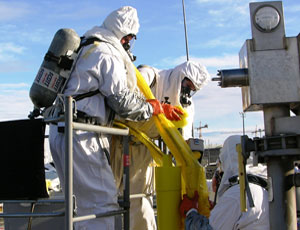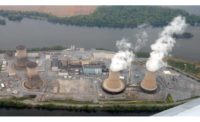Washington state sued the U.S. Energy Dept. Nov. 26 in federal district court in Spokane for failing to meet key milestones for cleaning up 53 million gallons of high-level radioactive waste at its 586-square-mile Hanford former nuclear weapons site near the Columbia River.

The lawsuit addresses DOE's pace in emptying 177 massive underground waste tanks, many of which date to the 1940s when atomic bombmaking began at Hanford, and are leaking into groundwater. The state is also demanding earlier completion of the site's $12.3-billion Waste Treatment Plant, which is years behind schedule, to produce glass logs from treated radioactive waste that will eventually be disposed of at the planned Yucca Mountain repository in Nevada.
Washington Gov. Christine Gregoire (D) and state Attorney General Rob McKenna want the court to act as an arbiter to set new cleanup deadlines and force DOE to abide by the revised timeline. They also want the agency and the U.S. Environmental Protection Agency to implement new groundwater and soil cleanup deadlines.
In a sharply worded statement, Gregoire said she was outraged with the slow pace at Hanford, which is the country's largest cleanup site. "In Washington state, we have been patient and reasonable in working with the federal agencies at Hanford," she said. "Our patience has run out."
The suit comes amid a stalemate between DOE and the state after 18 months of negotiations over how to proceed at Hanford. DOE has pushed back its expectations by decades on many key milestones, acknowledging it cannot meet legally binding targets. DOE, in its fiscal 2009 budget request, pushed its targeted site cleanup from 2035 to as late as 2062.
DOE, EPA and the Washington Dept. of Ecology reached a cleanup pact in 1989 known as the Tri-Party Agreement. Although its original deadlines have been amended since, the agreement says Hanford's 149 older single-shell tanks all must be emptied by 2018, and their waste treated and shipped from the site by 2028. The other 28 are newer double-shell vessels built since the 1960s.
DOE has said it will miss a February deadline to begin some operations at the Waste Treatment Plant and a 2011 deadline to fully operate the facility.
The department's new date for finishing the plant is 2019. In addition, only seven single-shell tanks have been emptied. Tanks can be emptied only at a pace of two to three a year, says the new tank farm contractor, Washington River Protection Solutions, a joint venture led by URS Corp.
DOE had a blunt reaction: "We have long maintained that litigation is costly and distractive," the department said. "We believe the department remained open and flexible throughout the negotiations, and we are disappointed that this issue will now be resolved through the litigation process."
Gregoire said she hopes President-elect Barack Obama (D) will address the cleanup. "With the help of our congressional delegation, and with a partner in the White House, I am hopeful that we can shift our focus from litigation to cleanup," she said. "Right now, however, the litigation is necessary to protect our state and its citizens."
But two state Congressional members, Democratic Sen. Patty Murray and Republican Rep. Doc Hastings issued a joint statement criticizing the suit.
"Now is not the time to set all that has been accomplished aside," they said. "Now is the time to work harder to find a path to an agreement and move forward."
But a Seattle-based watchdog group praised the legal action.
"Whatever the outcome of the lawsuit, we¹re certain it will prompt emptying of the tanks sooner than the 140 years that the current administra- tion envisions," says Gerald Pollet, executive director of Heart of America Northwest.


Post a comment to this article
Report Abusive Comment